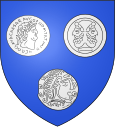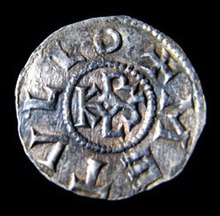Melle (Melle Deux-Sèvres)
| Melle | ||
|---|---|---|

|
|
|
| local community | Melle | |
| region | Nouvelle-Aquitaine | |
| Department | Deux-Sèvres | |
| Arrondissement | Niort | |
| Coordinates | 46 ° 13 ′ N , 0 ° 9 ′ W | |
| Post Code | 79500 | |
| Former INSEE code | 79174 | |
| Incorporation | 1st January 2019 | |
| status | Commune déléguée | |
| Website | https://mairie-melle.fr/ | |
Melle is a former French commune with 3,530 inhabitants (at January 1, 2017) in the department of Deux-Sèvres in the region Nouvelle-Aquitaine . It belonged to the Arrondissement of Niort and the Canton of Melle .
With effect from 1 January 2019 Melle with the previous communities Mazières-sur-Béronne , Paizay-le-Tort , Saint-Leger-de-la-Martinière and Saint-Martin-lès-Melle of the same name commune nouvelle Melle merged and have in the new municipality all the status of a Commune déléguée . The administrative headquarters are located in Melle.
geography
The small town is just under 60 kilometers southwest of Poitiers on the Via Turonensis , the westernmost of the four Camino de Santiago in France. It is another 200 km to Bordeaux . The area is crossed by the river Béronne in north-south direction, in the south runs the Légère .
history

Melle was called Metullum in ancient times - a name that is derived either from the Celtic word metl ('hill' or 'enclosure'), but which also has a certain similarity to the Latin term metallum . The mining of lead and silver ore ( galena ) has already been proven in Roman times . The Merovingians and Capetians also used the silver deposits ; They operated an important mint in the city as early as the early Middle Ages and thus ensured lasting prosperity for centuries. Mainly obolus and denarius were minted . The incidental lead was used for centuries to cover churches and cathedrals. From the High Middle Ages, the mines were only operated sporadically and were forgotten until they were rediscovered in 1830.
At the same time, Melle participated in the lively stream of pilgrims to Santiago de Compostela, which is still almost 1200 km away . The three important Romanesque churches, which testify to the former importance of the city, date from this heyday.
During the Hundred Years War (1337-1453) between England and France, Melle came temporarily (1363-1370) under English rule. During the Huguenot Wars , the place was besieged and affected - the royal governor was hanged. Catherine of Medici met her nephew, who would later become King Henry IV of France , in Melle in 1586.
economy
The most important economic factor is agriculture and especially cattle breeding. In the past, donkeys and mules were also bred, but these are no longer needed due to the increasing mechanization of agriculture.
Otherwise handicrafts and retail trade shape the economic life of the small town. From the production of sugar and ethyl alcohol in the 19th century, a medium-sized chemical plant emerged in the 20th century.
Population development
| year | 1975 | 1982 | 1990 | 1999 | 2006 | 2010 |
| Residents | 4,402 | 4.119 | 4,003 | 3,845 | 3,659 | 3,657 |
Attractions
Churches
St-Hilaire
St-Savinien
St-Pierre
More Attractions
In addition to the well-known churches, Melle has other sights:
- The Hôtel de Ménoc dates in part from the 15th century; renovations took place in the 19th century. It now serves as a courthouse.
- The former building of the Couvent des Capucins (Capuchin Monastery) dates from the 17th and 18th centuries and is now used by the city administration.
- The so-called Temple was the former church of the Protestants in Melle and is located directly at the former Protestant cemetery.
- The washhouse called Lavoir de Loubeau from the end of the 18th century with its elongated basin was given a roof in the 20th century. The wash house called Lavoir de Villiers from the mid-19th century has an oval basin.
- The Musée des Motocyclettes Monet et Goyon shows small motorcycles from the years 1920 to 1950.
- In the Marché de Melle , a historic market hall from the 19th century, vegetables as well as meat, fish and bread products are offered on market days.
- The Mines d'argent , the medieval lead and silver ore mines below the city, were rediscovered in 1830. They belong to the few - in parts accessible - medieval mines in Europe. In addition, the ancient craft of minting can be modeled.
- The arboretum is an educational tree trail along a disused railway line.
- Various newer works of art ( art in public spaces ) are distributed in the city center . The Pont aux Roses is a pink, eight-meter-long metal bridge sculpture that leads nowhere and was erected in a central square in the city in 2002 - due to the enormous cost, not without critical voices. Next to it is a fountain with the mosaic “Bestiaire Imaginaire” .
Personalities
- Marcel Brillouin , physicist, (born December 19, 1854 in Melle, † June 16, 1948 in Paris)
- Joseph Avenol , politician, (born June 9, 1879 in Melle, † September 2, 1951 in Duillier , Switzerland)
- René Hardy , member of the Resistance , (born October 31, 1911 in Mortrée, † April 12, 1987 in Melle)
- Guy Texereau , athlete, (born May 14, 1935 in Melle, † April 28, 2001 in Saint-Astier (Dordogne) )
- Laurent Cantet , filmmaker, (born June 15, 1961 in Melle)
literature
- Thorsten Droste : The Poitou. Western France between Poitiers and Angoulême - the Atlantic coast from the Loire to the Gironde. DuMont, Cologne 1999, ISBN 3-7701-4456-2 , p. 150ff.
- Dorothee Seiler: Saint-Hilaire in Melle and the Romanesque hall churches of Poitou. Tuduv-Verlag, Munich 1993, ISBN 3-8316-7489-2 .
- WHC Nomination Documentation (PDF, 88.9 MB), application documents for the nomination as World Heritage, here: section "Melle, Eglise Saint-Hilaire"
Web links
- Melle - Info (French)
- Melle - photos of the churches
- Melle - photos of the churches
- Melle - Eglise Saint-Hilaire. ( Memento from May 11, 2012 in the Internet Archive ) (French)
- Melle - St-Savinien, photos + text ( Memento from September 13, 2010 in the Internet Archive ) (French)
- Melle - St-Pierre, photos + text (French)
- Les monuments de la ville. ( Memento of November 13, 2008 in the Internet Archive ) Other sights in Melle - photos + text (French)
- Wash house - photos + text (French)
- Melle - coinage (Engl.)
- Melle - coinage of Ludwig the Pious
- Melle - ore mines
- Melle - Pont aux Roses


